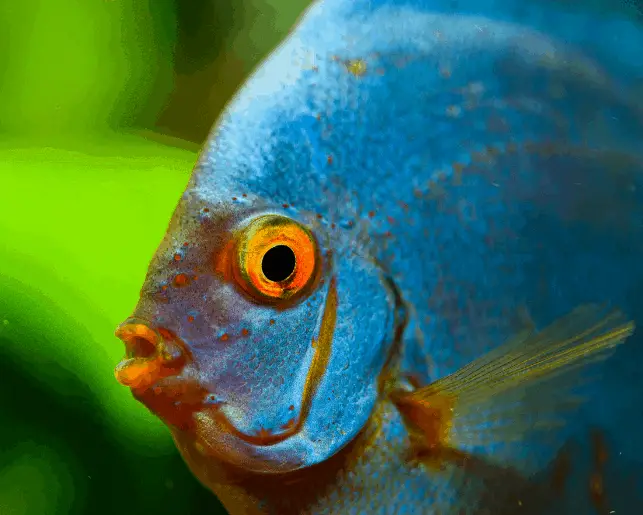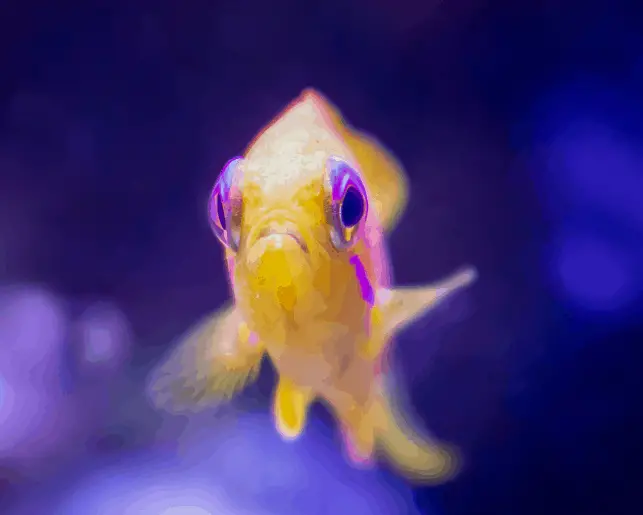Most humans have a habit of underestimating other animals, especially those we keep as pets. Most people only encounter fish on their dinner table and maybe an occasional visit to an aquarium, while some people keep fish as pets. It might surprise amateur aquarists how well their fish can see.
Tropical aquarium fish can generally clearly see objects within a few feet of their aquarium and detect motion within 10 feet (3.04 m). Because they evolved in an aquatic medium that absorbs and scatters light in a comparably short distance, fish did not evolve strong distance vision.
This article will explore the visual ability of tropical aquarium fish and some of the medical issues that can afflict their eyes.

How Well Do Aquarium Fish See?
Aquarium fish don’t see as well and are near-sighted compared to humans. In general, fish evolved in a much denser medium than land mammals, where visibility is limited. However, within their visual range, their vision may be better than a human’s vision.
Can Tropical Fish See Their Reflection in a Tank?
Tropical fish often can see their reflections in the tank if their tank is properly lit and made from reflective materials. Initially, seeing their reflection can be frightening and distressing to aquarium fish because they do not recognize their reflection as themselves.
Instead, they think their reflection is another fish. Bettas and other highly territorial species are known for making aggressive displays toward their reflection and may attack the glass. If they attack the glass, they can injure themselves.
The good news is that most fish will eventually realize that they cannot reach the “other fish” and learn to ignore their reflections. Aquariums made of non-reflective material and non-reflective coatings are also commercially available.
Some aquarists choose to attach a background to the back and sides of their tank to stop their fish getting stressed at the sight of their own reflection.
Can Tropical Fish See in the Dark?
Tropical fish cannot see in absolute darkness, but they can see considerably better than humans in low light conditions. This is due to the light-absorbing properties of water, and because fish have to have more rod cells in their eyes than humans.
Most tropical aquarium fish species are primarily active during the day and need periods of darkness to rest. As a result, their tanks or the rooms in which they’re placed should be kept dark at night. It is recommended to only have the lights on in the fish tank for no more than 10 hours in a 24 hour period.
Do Tropical Fish See Colour?
Not only can most tropical fish see colour, but they can often see a much wider range of colours than land mammals like humans. Human eyes have three types of cone cells corresponding to blue, green, and red wavelengths of light. Most tropical fish have four types of cone cells.
They can see every colour humans can, as well as colours in the ultraviolet wavelengths of light.
The possession of four types of cone cells means that fish can see colours most humans cannot even imagine.
A small percentage of humans are born with a genetic abnormality that causes their eyes to develop a fourth type of cone cell sensitive to near-ultraviolet light. These tetrachromatic people may have a similar colour vision to fish.
Some fish clades also possess the ability to see polarised light. It is theorised that this provides additional contrast and direction information in low light conditions. Detecting polarised light is entirely outside of human capability.
Can Tropical Fish Go Blind?
Tropical fish can go blind, and blindness is typically the result of untreated injuries, infections, or old age. A blind fish would have no chance of survival in the wild, either falling victim to predators or starvation. Blind aquarium fish can survive with the help of their human owners.
The trick is to help a blind fish find its food without the use of its eyes. In most cases, fish can learn to use their sense of smell to find food. This can be made easier by adding fragrant ingredients to fish food. Many experienced aquarists suggest the use of garlic.

Common Eye Problems for Tropical Fish.
Tropical aquarium fish can fall victim to several eye disorders and infections. Many fish eye disorders or injuries can be treated with simple medications like antibiotics dissolved in their tank’s water, but others are permanent or untreatable.
Some common eye problems in tropical aquarium fish are:
Bacterial Infection
The most common eye problems in aquarium fish are bacterial infections. Infections can cause swelling, cloudiness, and blindness if not properly treated. The most common bacterial infection is an aquatic form of tuberculosis, often found in aquarium water and freeze-dried fish food. Bacterial infections are usually treated by adding antibiotics to the aquarium water.
Cataracts
Similar to humans and other land mammals, the lens in a fish’s eye can become foggy. This severely limits the fish’s ability to see out of that eye and even blind the fish. Fish cataracts are often related to age and are currently untreatable.
Cloudy Eye
Cloudy Eye is a fogginess in parts of the eye other than the lens. Cloudy eyes may be caused by damage to the cornea (the outer layer), infections within the eye, poor water quality, and cancer.
The most common cause is physical trauma to the eye’s outer layer, and it will generally heal with time. Although if physical trauma is suspected, the fish’s environment should also be examined to work out what is the cause.
Corneal Ulcer
When fish suffer physical injury to their eyes’ protective cornea, the injury can occasionally become progressively worse due to a bacterial infection. This can result in an ulcer.
Corneal ulcers typically have to be diagnosed by a veterinary or vet tech through a dye test. They are treated through antibiotics applied directly to the affected eye.
Gas Bubble Disease
Fish can suffer from a medical condition similar to the “bends” experienced by human divers when they surface too quickly. Gas Bubble Disease (GBD) occurs when gases dissolved in water come out of solution instead of a fish’s eye, forming bubbles.
The bubbles can interfere with a fish’s vision and damage the internal tissues of the eye.
GBD in aquarium fish is typically caused by microscopic bubbles of air suspended in the aquarium water. These bubbles may make the water look foggy.
The two most common ways for gas microbubbles to be introduced to the water are a malfunctioning filter and aquarium waterfall features.
Veterinarians typically treat GBD by directly aspirating the gas bubbles with a small syringe and a very thin needle, sucking the bubbles out of the eye. The treatment will also include an antibiotic regimen.
Parasitic Infections
Single-celled organisms are not alone in making harmful homes inside unlucky fish’s eyes; multicellular parasites can do it too! The two most common fish eye parasites are eye flukes and protozoa called Cryptocaryon irritans (marine ich).
Eye flukes, technically called “Trematodes,” are tiny worms that colonize the interior fluids of a fish’s eyes. They’re one of the leading causes of Cloudy Eye.
Eye fluke infection has to be diagnosed by a veterinarian and is most often treated with the antiparasitic drug Praziquantel while the fish is confined to a quarantine tank,
Marine ich causes a condition called “white spot disease,” where white spots appear on a fish’s eyes and skin and cause Cloudy Eye. The most effective treatment for this infection is solutions of copper sulfate, but these can only be administered in a controlled clinical environment.
Quinine-based medications such as chloroquine phosphate and quinine diphosphate have been used to some success.
Pop-Eye
Some fish owners find this condition to be “cute”, but it really isn’t. “Pop-Eye,” technically called “enlargement” or “exophthalmia,” is a disorder where a fish’s eyes swell abnormally and protrude from its eye sockets.
This is not normal for most species of fish. If not treated, this condition can blind a fish or even cause it to lose its eyes.
“Pop-Eye” is caused by the accumulation of excess fluids within a fish’s eyeballs. The fluid accumulation can have several underlying causes, including but not limited to corneal injuries, bacterial or parasitic infections, poor water quality, and internal organ failure.
Treatment for exophthalmos depends on the underlying cause of the fluid accumulation. Water quality issues can be diagnosed and corrected at home with commercially available supplies.
Other causes have to be diagnosed and treated by a veterinary professional.
Related Posts:
What is a Quarantine Fish Tank?
How Fish See The World.
Fish see the world very differently from humans. Their eyes work differently than land vertebrates and are placed on fish’s heads differently.
In most species of tropical aquarium fish, their eyes are placed on opposite sides of their heads. This gives them a much wider field of monocular vision but a much narrower field of binocular vision. Fish generally have a field of vision wider than 150 degrees and often can see behind themselves.

How Fish Eyes Work.
Pay attention for the science stuff..
In most members of the clade Tetrapoda (meaning amphibians, reptiles, birds, and mammals), light enters through a transparent membrane called the cornea, passes through an opening called the pupil, and is focused by a lens onto a light-sensing tissue called the retina. The retina converts the light into electrical signals, which are processed by the brain.
The amount of light that enters the tetrapod eye is controlled by a muscular ring called the iris, which adjusts the width of the pupil by either contracting or relaxing. Tetrapod eyes generally adjust their focus by changing the shape of the flexible lens.
Fish eyes work differently than land vertebrates like humans and horses. Most fish eyes have fixed pupils and cannot directly regulate the amount of light that enters them. Also, fish adjust the focus of their vision by moving their eye lenses back and forth rather than changing their shape.
Another similarity between fish and tetrapod eyes is the use of light-sensing rods and cone cells to generate the electrical signals later analyzed by the brain. In both types of vertebrates, the rod cells function better in low light conditions, and the cone cells detect color.
Conclusion.
In terms of quality of sight, many animals are humanity’s equals or superiors.
Provided they are properly cared for and any disease or injury is treated early, tropical aquarium fish will visually explore their environment. They can even learn to recognize their owners after time.


